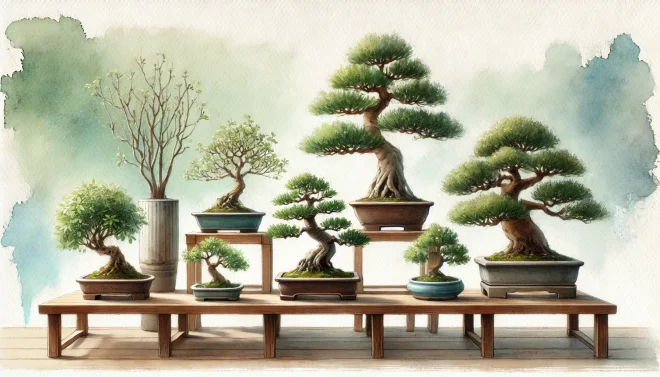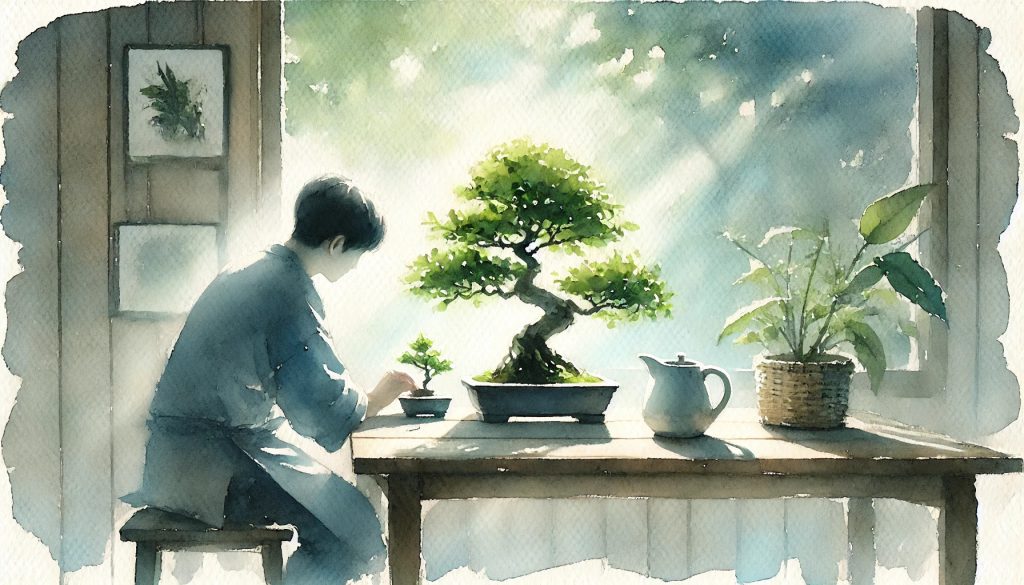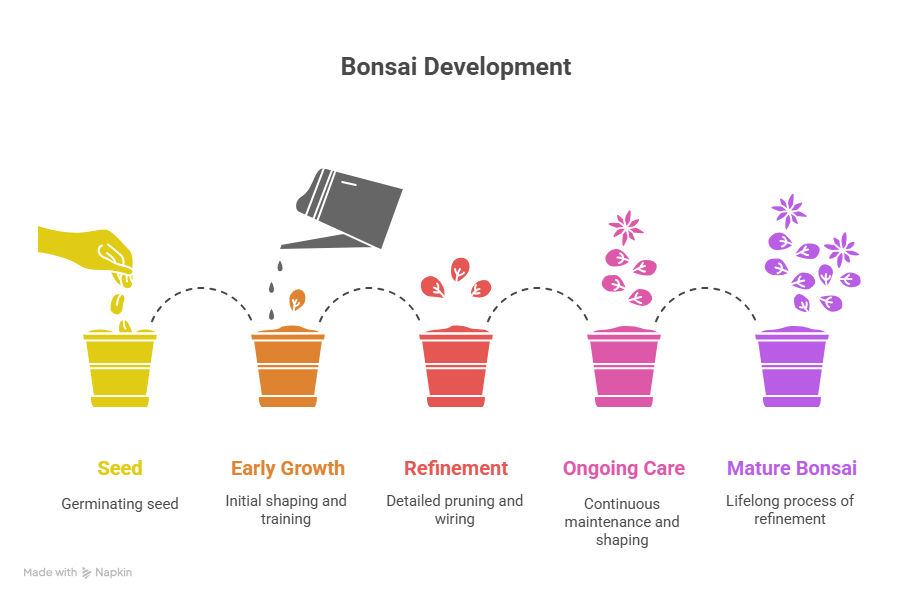
There is a reason bonsai has enchanted growers for centuries: it’s the perfect blend of horticulture and artistry, demanding equal parts patience and creativity. Each tree becomes a living sculpture, shaped not only by careful hands but also by the passage of time. That naturally leads to the big question every beginner asks: how long does it actually take to grow a bonsai tree?
The answer isn’t straightforward because no two bonsai journeys are alike. The species you choose, the age of the starting material, the environment it grows in, and the cultivation techniques you apply all play pivotal roles in shaping the timeline. What is consistent, however, is that bonsai is never a quick project. It’s a slow art form, where the years invested become part of the beauty itself.
1. The Two Major Stages of Bonsai Growth
Development Stage
This is where the groundwork is laid literally. During the development phase, growers focus on trunk thickening, root establishment, and building the basic structure that will define the bonsai’s future shape. It’s less about delicate pruning and more about letting the tree gain strength and stability.
Depending on whether you start from seed, a young sapling, or a pre-grown nursery tree, this stage can take anywhere from 4 to 10 years. The goal is not perfection, but potential: a solid framework ready to support artistic styling.
Refinement Stage
Once the bones of the tree are in place, the artistry begins. This stage centers on pruning, wiring, and shaping, adding the fine details that transform a young plant into a bonsai worthy of display. Here, patience is tested most, as refinement often stretches across 10 to 15 years or more. Unlike development, refinement is not about speed but precision. Each snip, twist, and guide of the wire adds character, slowly evolving the tree into a living expression of balance and beauty.
2. Growing Bonsai From Seed
For purists, starting from seed is the ultimate bonsai experience. It gives you complete control over the tree’s growth, style, and future character. From the very first sprout, every choice you make, soil mix, pruning, wiring shapes the tree into your unique vision. But this freedom comes with patience as the price tag. A seedling will take at least 4-5 years before it resembles anything close to a bonsai. Building a strong trunk and root system for a solid structural base can take 10-15 years. And even then, the refinement stage continues for decades, as the tree matures into its artistic potential. Sources like Bonsai Empire [1], Bonsai Store [2], and Bonsai Galinou [4] all emphasize the same truth: bonsai from seed is a long road, but one that offers unmatched satisfaction for those willing to wait.
3. Starting With Pre-Grown or Nursery Trees
For hobbyists and newcomers, starting with a pre-grown tree is the most practical route. These trees are typically 5-7 years old, which means they’ve already passed the slow, vulnerable years of early development. The biggest advantage? You skip the years of waiting for a seedling to establish itself. Instead, you can dive into the rewarding part sooner, pruning, wiring, and shaping within just a few years of care. For many enthusiasts, this option strikes the perfect balance: you still get the joy of styling and nurturing your bonsai, but without the decades-long commitment required when starting from scratch.

ATL TAG: A watercolor painting of a serene scene featuring a person carefully growing and tending to a bonsai tree.
4. Species and Growth Rate Factors
Not all bonsai grow at the same pace. Some species, like maples, are relatively fast growers and can bulk up their trunks and branches within a few years. Others, like pines and junipers, are famously slow, requiring extra patience but rewarding growers with longevity and timeless character. Beyond species, the environment plays a huge role. Soil quality, watering routines, available light, and local climate all influence how quickly (or slowly) a bonsai develops. A tree in optimal conditions will establish itself far faster than one struggling against poor soil or inconsistent care. Cultivation practices are equally important. Regular root pruning encourages finer root systems, while pot size directly affects how much a tree can expand. Fertilization, too, is key to providing the nutrients that fuel healthy, steady growth.
5. How Long Until a Bonsai Reaches Maturity?
The honest answer: a bonsai doesn’t have a finish line. From seed to a refined, display-worthy tree, expect 10 to 30 years or more. True artistry in bonsai is less about ticking off years and more about a lifelong process of refinement and care. Some bonsai trees live and continue evolving for over 100 years. In fact, many of the most admired bonsai in collections today are generations old, shaped by multiple caretakers across time.

6. Patience and the Art of Bonsai
Ask any seasoned grower, and they’ll tell you: bonsai is not a project, it’s a journey. The trees are never really “done.” Instead, they continue to grow, shift, and refine with every season. Consistent care, regular pruning, wiring, repotting, and observation is what allows a bonsai to gradually reveal its character. It’s this ongoing relationship that makes the practice so rewarding. Bonsai isn’t about reaching an end product; it’s about the act of shaping and nurturing, year after year.
Summary Timeline (Quick Reference)
- Seed → bonsai form: 4-5 years
- Basic structure: 10-15 years
- Mature bonsai artistry: 10-30 years or more
- Pre-grown bonsai starting age: 5-7 years
- Lifespan: decades to over 100 years
Conclusion
After reviewing expert sources and timelines across bonsai communities, one truth stands out: growing a bonsai is a long-term commitment measured in decades, not months. From seed, you’ll need at least 4-5 years before seeing a recognizable form and 10-15 years for a solid structure, while pre-grown nursery trees can accelerate the process. Yet even then, refinement and artistry remain lifelong pursuits. Many bonsai live for over a century, shaped by generations of hands. In essence, bonsai is not just horticulture, it’s a living art that rewards patience, precision, and a willingness to grow alongside the tree itself.
FAQs about How Long Does Bonsai Tree Take To Grow?
1.How long does it take to grow a bonsai tree from seed?
Growing from seed takes patience expect at least 4-5 years before you see a tree resembling bonsai form, and 10–15 years to establish a solid structure.
2. Can I speed up the process by starting with a pre-grown bonsai?
Yes. Nursery bonsai are usually 5-7 years old, allowing you to skip the slow early years and start styling much sooner.
3. Which bonsai species grow the fastest?
Maples and elms tend to grow faster, while pines and junipers are slower but develop long-lasting, character-rich forms.
4. Do bonsai trees ever stop growing?
No. Bonsai are living trees. With proper care, they continue growing and evolving for decades—some even live for over 100 years.
5.Is bonsai more about gardening or art?
It’s both. Bonsai combines horticultural skills watering, pruning, root care with artistic styling, making it a lifelong creative journey.
YOU MIGHT ALSO LIKE TO READ: How to Get a Crane Operator License in USA
GIPHY App Key not set. Please check settings